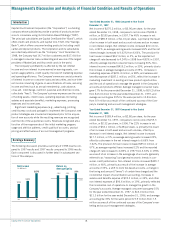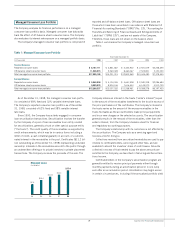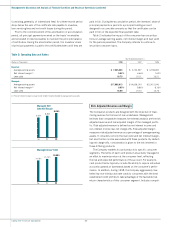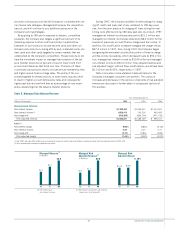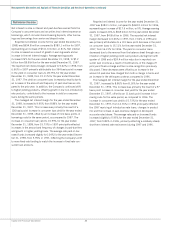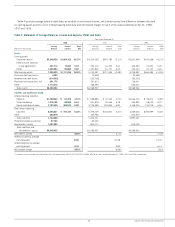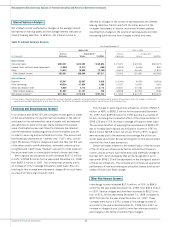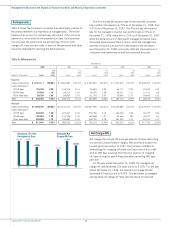Capital One 1998 Annual Report Download - page 21
Download and view the complete annual report
Please find page 21 of the 1998 Capital One annual report below. You can navigate through the pages in the report by either clicking on the pages listed below, or by using the keyword search tool below to find specific information within the annual report.
19 Capital One Financial Corporation
Table 1: Managed Consumer Loan Portfolio
Year Ended December 31
(In Thousands) 1998 1997 1996 1995 1994
Year-End Balances:
Reported consumer loans $ 6,157,111 $ 4,861,687 $ 4,343,902 $ 2,921,679 $2,228,455
Off-balance sheet consumer loans 11,238,015 9,369,328 8,460,067 7,523,801 5,150,000
Total managed consumer loan portfolio $17,395,126 $14,231,015 $12,803,969 $10,445,480 $7,378,455
Average Balances:
Reported consumer loans $ 5,348,559 $ 4,103,036 $ 3,651,908 $ 2,940,208 $2,286,684
Off-balance sheet consumer loans 9,860,978 8,904,146 7,616,553 6,149,070 3,910,739
Total managed consumer loan portfolio $15,209,537 $13,007,182 $11,268,461 $ 9,089,278 $6,197,423
Managed Consumer Loan Portfolio
The Company analyzes its financial performance on a managed
consumer loan portfolio basis. Managed consumer loan data adds
back the effect of off-balance sheet consumer loans. The Company
also evaluates its interest rate exposure on a managed portfolio basis.
The Company’s managed consumer loan portfolio is comprised of
As of December 31, 1998, the managed consumer loan portfo-
lio consisted of 68% fixed and 32% variable interest rate loans.
The Company’s reported consumer loan portfolio as of December
31, 1998, consisted of 62% fixed and 38% variable interest
rate loans.
Since 1990, the Company has actively engaged in consumer
loan securitization transactions. Securitization involves the transfer
by the Company of a pool of loan receivables to an entity created
for securitizations, generally a trust or other special purpose entity
(“the trusts”). The credit quality of the receivables is supported by
credit enhancements, which may be in various forms including a
letter of credit, a cash collateral guaranty or account, or a subordi-
nated interest in the receivables in the pool. Certificates ($11.2 bil-
lion outstanding as of December 31, 1998) representing undivided
ownership interests in the receivables are sold to the public through
an underwritten offering or to private investors in private placement
transactions. The Company receives the proceeds of the sale. The
Company retains an interest in the trusts (“seller’s interest”) equal
to the amount of the receivables transferred to the trust in excess of
the principal balance of the certificates. The Company’s interest in
the trusts varies as the amount of the excess receivables in the
trusts fluctuates as the accountholders make principal payments
and incur new charges on the selected accounts. The securitization
generally results in the removal of the receivables, other than the
seller’s interest, from the Company’s balance sheet for financial
and regulatory accounting purposes.
The Company’s relationship with its customers is not affected by
the securitization. The Company acts as a servicing agent and
receives a fee for doing so.
Collections received from securitized receivables are used to pay
interest to certificateholders, servicing and other fees, and are
available to absorb the investors’ share of credit losses. Amounts
collected in excess of that needed to pay the above amounts are
remitted to the Company, as described in Servicing and Securitiza-
tions Income.
Certificateholders in the Company’s securitization program are
generally entitled to receive principal payments either through
monthly payments during an amortization period or in one lump
sum after an accumulation period. Amortization may begin sooner
in certain circumstances, including if the annualized portfolio yield
reported and off-balance sheet loans. Off-balance sheet loans are
those which have been securitized in accordance with Statement of
Financial Accounting Standards (“SFAS”) No. 125, “Accounting for
Transfers and Servicing of Financial Assets and Extinguishments of
Liabilities” (“SFAS 125”), and are not assets of the Company.
Therefore, those loans are not shown on the balance sheet.
Table 1 summarizes the Company’s managed consumer loan
portfolio.
$17.4
$12.8
$14.2
$10.4
$7.4
Managed Loans
(In Billions)
9594 96 97 98











